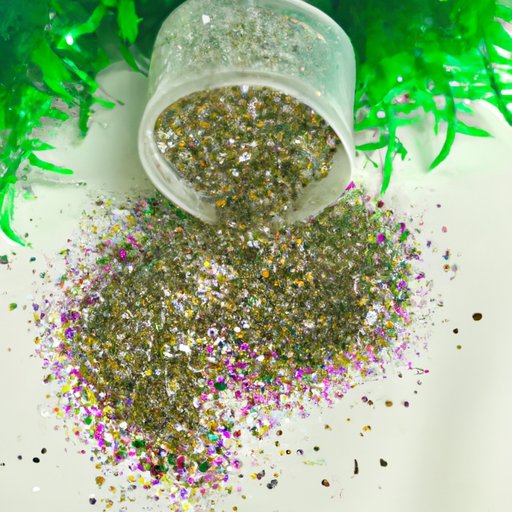
Introduction
Glitter is a fun and sparkly addition to any art project or DIY craft. However, the commercial glitter sold in stores is often made of plastic and has negative effects on the environment. Making your own glitter at home is a great alternative and can be a fun activity for adults and kids alike. In this article, we will provide a step-by-step guide for making your own glitter, explore the history and cultural significance of glitter, provide easy-to-follow DIY projects, discuss the negative environmental impact of commercially-made glitter, and highlight the benefits of glitter for self-care, therapy, and social movements.
Step-by-Step Guide
To make your own glitter, you will need the following materials and tools:
– Epsom salt
– Food coloring or liquid watercolors
– Small mixing bowls
– Baking sheets
– Parchment paper
– Oven
To begin, preheat your oven to 350°F. Then, pour a cup of Epsom salt into a mixing bowl. Add a few drops of food coloring or liquid watercolors to the bowl and mix until the salt is evenly coated. You can experiment with different color combinations to create custom glitter colors.
Next, spread the salt evenly onto a baking sheet lined with parchment paper. Place the sheet in the oven and bake for 10-15 minutes or until the salt has dried out completely. Once the salt has cooled, you can remove it from the oven and break it up into small pieces.
You can now use your homemade glitter to add sparkle to art projects, DIY crafts, and more. Store your glitter in an airtight container in a cool, dry place.
Historical Background
Glitter has been used in various forms for centuries. In the early days, glitter was made from crushed insects, shells, and glass. During the Renaissance, glitter was used to embellish artwork and clothing. Fast forward to the 20th century, and glitter became a popular decoration for disco balls and costumes. Today, glitter is used in a wide range of crafts and products, from makeup to phone cases.
DIY Projects
One of the great things about making your own glitter is that you can use it to create custom DIY projects. Here are a few easy-to-follow tutorials for DIY projects featuring glitter:
1. Glitter Slime – Mix your homemade glitter with glue and borax to create a fun and stretchy slime.
2. Glitter Ornaments – Add sparkle to your holiday decorations by filling clear plastic ornaments with glitter.
3. Glitter Candles – Dip the bottom of a candle into glue and then roll it in glitter to add a pop of color to any room.
These projects are just the beginning. With a little creativity, you can add glitter to almost anything.
Glitter Impact on the Environment
Unfortunately, commercially-made glitter can have negative effects on the environment. Most glitter is made from plastic and is not biodegradable. This means that when glitter ends up in the ocean or other bodies of water, it can harm wildlife and pollute the environment.
To combat this, many companies are now creating biodegradable glitter made from materials like cellulose or plant-based materials. You can also make your own biodegradable glitter by using materials such as salt, sugar, or mica powder.
Benefits of Glitter
While glitter can have negative effects on the environment, it can also have positive effects on people and society. Research has shown that using glitter in self-care and therapy can be beneficial for mental health. For example, glitter can provide a calming sensory experience and help alleviate anxiety.
Glitter has also been used as a symbol of social movements, such as the glitter bombing that became popular during the LGBTQ+ rights movement. Glitter has become a way to express oneself and stand out in a crowd.
Additionally, making your own glitter can be a therapeutic activity. It allows you to be creative and provides a sense of accomplishment when you see the finished product.
Conclusion
In conclusion, making your own glitter is a fun and easy way to add sparkle to your life while also being environmentally conscious. We explored the step-by-step guide for making homemade glitter, the history and cultural significance of glitter, easy-to-follow DIY projects, and the negative environmental impact of commercially-made glitter. We also discussed the benefits of using glitter in self-care, therapy, and social movements. We hope this article inspires you to try making your own glitter at home and to use environmentally-friendly glitter options.




